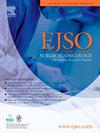Long-term survival analysis after radical gastrectomy for Epstein-Barr virus-associated gastric cancer: A multicenter study
IF 3.5
2区 医学
Q2 ONCOLOGY
引用次数: 0
Abstract
Background
The prognosis of Epstein-Barr virus-associated gastric cancer (EBVaGC)needs to be validated by high-quality studies. This study aimed to assess the long-term survival of EBVaGC patients after radical gastrectomy using multicenter data to explore the potential value of EBV infection status as a prognostic predictor.
Methods
We analyzed the clinical data of patients with EBVaGC and Epstein-Barr virus-negative gastric cancer (EBVnGC) who underwent radical gastrectomy from January 2013 to July 2020. The Kaplan-Meier method and Cox regression analysis were used to evaluate overall survival (OS) and disease-free survival (DFS). A Random Survival Forest (RSF) model was constructed to predict the prognosis.
Results
After propensity score matching, 205 and 410 patients were included in the EBVaGC and EBVnGC groups, respectively. The 3-year OS and DFS rates in the EBVaGC group were significantly higher than those in the EBVnGC group. Multivariate analysis indicated that EBER(Epstein-Barr virus-encoded small RNA) positivity was an independent protective factor for OS and DFS. Among stage II and III EBVaGC patients, those receiving ≥4 cycles of chemotherapy had a 3-year OS significantly better than those receiving <4 cycles. The RSF model based on EBER status outperformed the Cox model and TNM staging system in predicting the 3-year OS and DFS.
Conclusion
The prognostic prediction model established based on the EBER status has good clinical application value and can provide a new reference for clinical follow-up management. It is recommended that patients with stage II and III EBVaGC receive at least four cycles of chemotherapy postoperatively to improve survival.
求助全文
约1分钟内获得全文
求助全文
来源期刊

Ejso
医学-外科
CiteScore
6.40
自引率
2.60%
发文量
1148
审稿时长
41 days
期刊介绍:
JSO - European Journal of Surgical Oncology ("the Journal of Cancer Surgery") is the Official Journal of the European Society of Surgical Oncology and BASO ~ the Association for Cancer Surgery.
The EJSO aims to advance surgical oncology research and practice through the publication of original research articles, review articles, editorials, debates and correspondence.
 求助内容:
求助内容: 应助结果提醒方式:
应助结果提醒方式:


